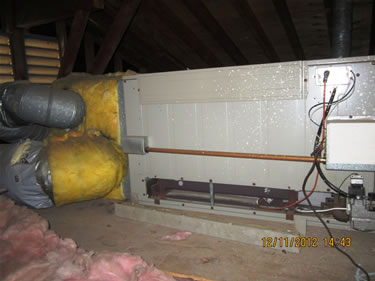During the 1980's housing boom, horizontal furnaces were widely installed in homes. These units seemed a wise choice for builders at the time, as they were cost effective and were easily installed into attic spaces. The H-Series by Consolidated Industries, which was marketed under the Premier label, is one of the most commonly selected and is installed in thousands of homes throughout the southwestern United States. Other companies also sold furnaces built by Consolidated Industries, but under their own label.
 Furnace by Consolidated Industries in a San Diego homeThe H-Series went into production in 1983 and continued to be produced until 1991. Within this series are three different furnaces: HAC, HCC, and HCA. The latter of the two were the result of changes to ANSI standards in an attempt to make the units safer. These elevated safety standards were not met by the HAC models. Production of all H-Series furnaces came to a halt in 1991 as none met the newer Federal efficiency standards. Sales continued for a period of time afterwards in order to sell off remaining inventory. It is estimated that as many as 1.2 million H-Series units were sold in total.
Furnace by Consolidated Industries in a San Diego homeThe H-Series went into production in 1983 and continued to be produced until 1991. Within this series are three different furnaces: HAC, HCC, and HCA. The latter of the two were the result of changes to ANSI standards in an attempt to make the units safer. These elevated safety standards were not met by the HAC models. Production of all H-Series furnaces came to a halt in 1991 as none met the newer Federal efficiency standards. Sales continued for a period of time afterwards in order to sell off remaining inventory. It is estimated that as many as 1.2 million H-Series units were sold in total.In 1994, a large number of H-Series failures began to be reported. There were particularly large numbers in California, Texas, and North Carolina. These problems were related to both failure of the burner assemblies as well as the heat exchangers. With a large number of failures being reported, several investigations into the causes were launched. During this time, Consolidated Industries placed blame on improper installation and maintenance.
It was during this same time that fire investigators were realizing an increase in the number of fires that occurred in homes containing H-Series furnaces. Since the furnaces were installed on plywood decking or wooden joists within the attic space, the initial thought was that heat was being passed from the unit into the wood and causing fires. This was despite the fact that the units were labeled as safe for installation on combustible surfaces. Pyrolysis (decomposition ratio of fuel to heat, aka buring wood) was listed as the cause and recommendations were made to have horizontal furnaces no longer be installed on combustible flooring. Unfortunately this apparent quick fix did not take into account the science behind heat transfer. Heat will move through a solid more readily than through air space, so there was little improvement using this method.
Upon further examination it became clear that the problem was much deeper than simple pyrolysis. State of California air quality requirements had forced Consolidated Industries to make changes to the furnaces that would be sold in California. These changes included the addition of rods that would be used to absorb the heat emitted from the burner flame.
Since nitrates mix with oxygen and produce nitrous oxide under high-heat conditions, the change was intended to lower the heat and thus reduce the amount of nitrous oxide, allowing the units to meet California air quality standards. These rods, referred to as "NOX rods", were not found in all units. Some furnaces in San Diego, San Luis Obispo, and Ventura were found not to have them.
What testing would soon reveal in furnaces retrofitted with NOX rods is that cracks were forming in the metal webs installed between the gas port openings and the burner tubes. Over time as the furnace continued to be used, these cracks would grow larger. With more gas and air being able to pass through, controlled burner flames became irregular, allowing them to reach the heat exchanger cells. A faulty fabrication process was cited as the reason for the formation of cracks.
H-Series furnace problems result in two life-threatening possibilities. One would be the potential for the unit to emit carbon monoxide into the living space. This toxic gas is both odorless and colorless. Once absorbed into the body in sufficient quantity, death can occur. The second possibility is fire. This can be the direct result of damaged units allowing combustion air to enter the heat exchanger and combine with circulation air. In some cases, this can pressurize the air within the furnace causing a "flame rollout" where the flame escapes the furnace cabinet and can ignite surrounding combustable materials.
At this time, inspection is recommended on all H-Series furnaces. Both a visual and internal inspection is recommended. Though replacement of the burner assembly or heat exchanger is possible, these would only be temporary fixes and failure will likely occur in the future. The safest course of action will be a total replacement of any H-Series furnace that was produced by Consolidated Industries.
If you are in California and wish to get additional information regarding defective furnaces, you can call the furnace recall hotline at (877) 347-6456. Or read the original furnace recall press release at the CPSC website.


